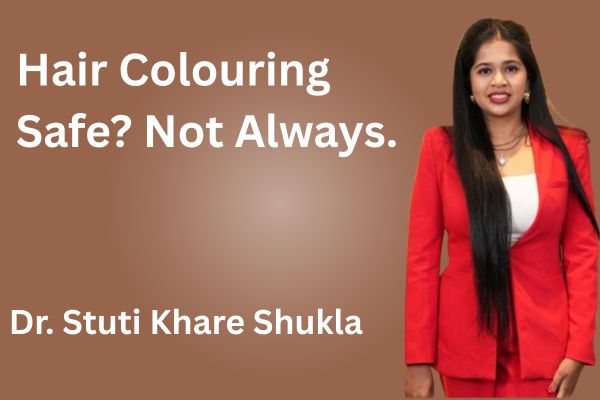Hair Colouring Safe – Hair colouring can be transformative and liberating—but is it truly as safe as we believe? This comprehensive guide explores the “Hair Colouring Safe” debate: the allure, the hidden hazards, expert perspectives, and whether it’s still worth the risk.
Hair Colouring Safe? – The Popular Practice
Hair colour—from permanent to semi-permanent—ranks among the most popular beauty treatments worldwide. It offers self-expression, covers greys, and refreshes your look with minimal effort. However, every colour range and brand carries different formulations, with outcomes varying by frequency and technique.
Hair Colouring Safe? – Common Risks and Side Effects
- Scalp irritation & allergies: Ingredients like PPD (paraphenylenediamine) can cause itching, redness, rashes, or burning sensations. Patch testing is always advised.
- Hair damage: Permanent dyes contain ammonia and hydrogen peroxide, which open the cuticle and strip natural oils—often resulting in brittle, straw-like strands.
- Hair loss: Chemicals weaken disulfide bonds, increasing breakage and shedding.
- Health concerns: Studies link repeated exposure to harsh dye chemicals with an elevated risk of cancers—particularly blood, bladder, breast, and uterine cancers. Key culprits include aromatic amines, PPD, and formaldehyde-releasing agents.
- Dryness and split ends: Frequent dyeing exacerbates dryness, frizz, and ends damage.
Hair Colouring Safe? – Real-World Community Insights
Anecdotal accounts from users across forums reflect genuine concerns:
“Using box dye caused significant hair fall and texture damage—my hair is now much weaker.”
“Salon balayage was fine—no noticeable fallout or dryness—as long as my aftercare routine was solid.”
Hair Colouring Safe? – What Dermatologists Recommend
Dr. Stuti Khare Shukla emphasizes dermatology-guided approaches:
- Prioritize hair health and scalp condition before any cosmetic procedure—especially professional treatments like her Hair Growth Booster®, which focus on nourishing the root cause, not just the surface.
- Minimize usage of harsh dyes; when needed, opt for ammonia-free, low-damage, or natural alternatives (like pure henna).
- Always follow dyeing with supportive care: deep conditioners, masks, protective products, and scalp-friendly oils
- Monitor nutritional status (e.g., biotin, iron, zinc, vitamins A/C) to support hair resilience.
Hair Colouring Safe? – Safer Alternatives
| Type | Pigment Damage | Color Duration | Recommended For |
| Permanent dyes | High | Long-lasting | For major colour shift |
| Demi-permanent | Medium | ~20–28 washes | For gray blending |
| Semi-permanent | Low | 4–8 washes | For subtle tones |
| Henna & natural | Gentle | Varies | Mild change, hair strength |
| Temporary rinses | Minimal | 1 wash only | Events/daily color swap |
Note: Regular semi-permanent dyes may still contain PPD or other potentially harmful components.
Hair Colouring Safe? – Best Practices
- Patch test to avoid allergic reactions, despite varied opinions on accuracy.
- Use professional services for precise application and minimal scalp exposure. Avoid DIY box dyes.
- Space out treatments—frequent coloring increases chemical stress on hair and skin.
- Prioritize less aggressive techniques: demi-perm or root touch-ups instead of full dyeing.
- Post-colour care: sulfate-free shampoo, mask twice weekly, leave-in serums, and occasional deep repair.
- Inhale-cautious practices in salons—especially when using straighteners that emit formaldehyde vapour—supporting proper ventilation.
Dr. Stuti Khare Shukla Contact Information
Social Media Links:-
More Ways to Contact:-
Conclusion
Hair colouring isn’t inherently dangerous, but its cumulative impact—especially when misused or overused—can lead to brittle hair, scalp issues, and health concerns. Ensuring “Hair Colouring Safe” routines means balancing aesthetic goals with scalp wellness, dermatologist-endorsed practices, and intelligent product choices.
If you’re planning a color transformation, starting with a scalp assessment, scalp-nourishing protocols, and mindful aftercare (as recommended by Dr. Stuti Khare Shukla) is the safest path to vibrant—and healthy—hair.
Hair Colouring Safe FAQs
Q1: Is it safe to colour hair every few weeks?
A: Cumulatively, no—frequent colouring increases the risk of scalp irritation, structural damage, and potential long-term health risks.
Q2: Can natural dyes like henna completely replace synthetic dyes?
A: Henna can colour gradually and strengthen strands—but offers a narrower shade range and can still cause dryness if misused.
Q3: Does colour cause greying faster?
A: Grey progression is mostly genetic; colouring doesn’t induce it—but poor aftercare may increase breakage, making greys more visible.
Q4: Can hair fall from colour be reversed?
A: Hair breakage around the time of colouring can be managed with strong aftercare and nutritional support—once follicular health is restored.
Q5: Are low-ammonia or developer-free products safer?
A: They are less damaging but still require responsible usage and post-care. Avoid repeated processes like bleaching every month.
Related Tags:-
- best hair doctor in India
- hair growth queen of India
- dermatologist for hair growth
- best hair treatment in Mumbai
- non surgical treatment for hair loss
- Hair Growth Booster®
- Awards and Achievements
- Best Hair Fall Treatments in India
- Hair Transplant
- Hair Transplant vs. Hair Growth Booster®
- How to Stop Hair Loss in Women Naturally
- Top 5 Causes of Sudden Hair Loss
- Hair Growth Results
- Teenage Hair Fall Treated Without Surgery
- Dry Hair After Wash
- Keratin Treatment
- The Dark Side of Daily Heat Styling
- Coloured + Damaged Hair
- Hair Oiling
- Hair Colouring Safe

